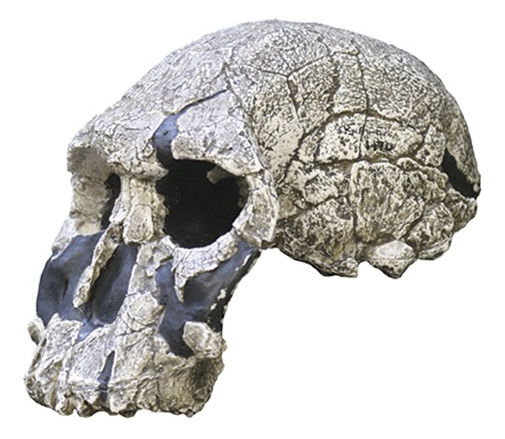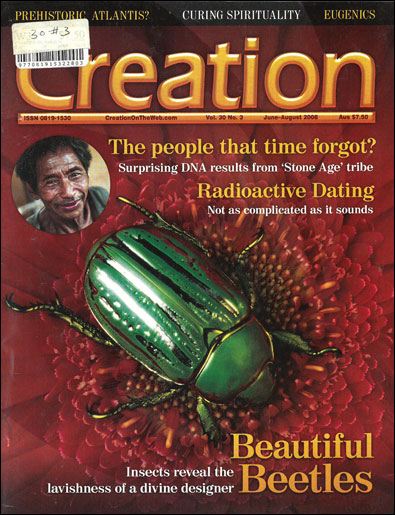How dating methods work

Addressing the students, I used a measuring cylinder to illustrate how scientific dating works. My picture showed a water tap dripping into the cylinder. It was clearly marked so my audience could see that it held exactly 300 ml of water. The diagram also showed that the water was dripping at a rate of 50 ml per hour.
I asked, ‘How long has the water been dripping into the cylinder?’
Immediately someone called out, “Six hours.”
“Good. How did you work that out?”
“By dividing the amount of water in the cylinder (300 ml) by the rate (50 ml per hour).”
“Excellent,” I said. “See how easy it is to calculate the age of something scientifically? Every dating method that scientists use works exactly the same way. It involves measuring something that is changing with time.”
People began to relax once they understood that the science of dating is not so difficult. Then I surprised them, “The problem is that six hours is the wrong answer.”
They look puzzled and disbelieving.
“I set this experiment up and I can tell you that the water has only been dripping for one hour. Can you tell me what happened?”

After they had composed themselves, someone called out, “The tap was dripping faster in the past?”
“Perhaps,” I said.
“The cylinder was nearly full when you started?”
“Maybe. But can you see what you are doing?” I asked. “In order to calculate an age you made assumptions about the past. You assumed the rate had always been 50 ml per hour and that the cylinder was empty when it started. Based on those assumptions you calculated the time of 6 hours.”
They nodded.
“You were perfectly happy with that answer. Not one of you challenged it.” They agreed.
“Then, when I told you the correct answer, do you realize what you did? You quickly changed your assumptions about the past in order to agree with the age I told you.”
Every scientist must first make assumptions about the past before he can calculate an age. If the result seems okay then he will happily accept it. But if it does not agree with other information then he will change his assumptions so that his answer does agree.
It does not matter if the calculated age is too old or too young. There are always many assumptions a scientist can make to get a consistent answer.
Suddenly the lights went on. My audience saw, in a nutshell, the way dating methods work.1 Scientific dating is not a way of measuring but a way of thinking.
How it works in practice

A layer of volcanic ash in East Africa, called the KBS tuff, became famous through the human fossils found nearby.2
Using the potassium-argon method, Fitch and Miller were the first to measure the age of the tuff. Their result of 212–230 million years did not agree with the age of the fossils (elephant, pig, ape and tools) so they rejected the date. They said the sample was contaminated with excess argon.3
Using new samples of feldspar and pumice they ‘reliably dated’ the tuff at 2.61 million years, which agreed nicely.
Later, this date was confirmed by two other dating methods (paleomagnetism and fission tracks), and was widely accepted.
Then Richard Leakey found a skull (called KNM-ER 1470) below the KBS tuff, a skull that looked far too modern to be 3 million years old.
So Curtis and others redated the KBS tuff using selected pumice and feldspar samples, and obtained an age of 1.82 million years. This new date agreed with the appearance of the new skull.4
Tests by other scientists using paleomagnetism and fission tracks confirmed the lower date.
So by 1980 there was a new, remarkably concordant date for the KBS tuff, and this became the one that was widely accepted.
Which illustrates that, contrary to popular belief, the dating methods are not the primary way that ages are decided. The dating methods do not lead but follow. Their results are always ‘interpreted’ to agree with other factors, such as the evolutionary interpretation of geology and fossils.
Re-posted on homepage: 28 October 2023
References and notes
- For further information see: Sarfati, J., Diamonds: a creationist’s best friend, Creation 28(4):26–27, 2006; creation.com/diamonds, and Walker, T., The way it really is: little-known facts about radiometric dating, Creation 24(4):20–23, 2002; creation.com/dating-reality. Return to text.
- For more information see Lubenow, M.L., The pigs took it all, Creation 17(3):36–38, 1995; creation.com/pigstook. Return to text.
- Fitch, F.J. and Miller, J.A., Radioisotopic age determinations of Lake Rudolf artifact site, Nature 226(5242):226–228, 1970. Return to text.
- Curtis, G.H., et al., Age of KBS Tuff in Koobi Fora Formation, East Rudolf, Kenya, Nature 258:395–398, 4 December 1975. Return to text.












Readers’ comments
Comments are automatically closed 14 days after publication.